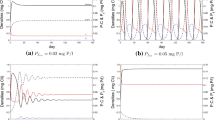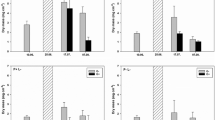Abstract
Substrate supply and grazing are the factors with the greatest potential for short-term control of planktonic bacterial density and productivity. A model was developed based on Monod kinetics, where growth rates are limited by food supply in a saturation type equation. In the model, substrate, bacteria, heterotrophic flagellates and zooplankton are state variables linked by trophic transfer and expressed as carbon. The steady state assumption allows calculation of equations indicating the following: (l) bacterial density is determined primarily by the ratio of substrate input to grazing rate; (2) bacterial production is balanced by a combination of losses due to maintenance, death and grazing, and occurs at a rate determined by the rate of substrate input and the growth yield; (3) ambient substrate concentration is directly related to grazing rate.
Sensitivity analysis of the model on a computer demonstrates some differences between grazer-controlled and substrate-controlled bacterial systems, and predictions of the model are listed for possible validation in natural systems. The model is potentially useful in evaluating the ‘link vs. sink’ question, as it provides a framework for investigating energy flow through the microbial food web as a function of controlling factors.
Similar content being viewed by others
References
Anderson, P. & T. Fenchel, 1985. Bacterivory by microheterotrophic flagellates in seawater samples. Limnol. Oceanogr. 30: 198–202.
Azam, F., T. Fenchel, J. G. Field, J. S. Gray, L. A. Meyer-Reil & F. Thingstad, 1983. The ecological role of water-column microbes in the sea. Mar. Ecol. Prog. Ser. 10: 257–263.
Bell, Russell T., 1986. Thymidine incorporation as a measure of bacterial production in lakes. Acta Univ. Upsaliensis 43, 1986.
Billén, G., C. Joiris, J. Wijnant & G. Gillain, 1980. Concentration and microbiological utilization of small organic molecules in the Scheldt Estuary, the Belgian coastal zone of the North Sea and the English Channel. Est. Coastal Mar. Sci. 11: 279–294.
Ducklow, H. W., 1983. Production and fate of bacteria in the oceans. Bioscience 33: 494–501.
Ducklow, H. W., D. A. Purdie, P. J. LeB. Williams & J. M. Davies, 1986. Bacterioplankton: a sink for carbon in a coastal marine plankton community. Science 232: 865–867.
Fenchel, T., 1982. Ecology of heterotrophic microflagellates. IV Quantitative occurrence and importance as bacterial consumers. Mar. Ecol. Prog. Ser. 9: 35–42.
Fenchel, T., 1986. The ecology of heterotrophic microflagellates. Adv. in Microbial Ecol. 9: 57–97.
Fuhrman, J. A. & F. Azam, 1980. Bacterioplankton secondary production estimates for coastal waters of British Columbia, Antarctica, and California. Appl. Envir. Microb. 39: 1085–1095.
Graham, J. M. & R. P. Canale, 1982. Experimental and modeling studies of a four-trophic level predator-prey system. Microb. Ecol. 8: 217–232.
Herbert, D., R. Elsworth & R. C. Telling, 1956. The continuous culture of bacteria: a theoretical and experimental study. J. Gen. Microbiol. 14: 601–622.
Laake, M., A. B. Dahle, K. Eberlein & K. Rein, 1983. A modelling approach to the interplay of carbohydrates, bacteria and nonpigmented flagellates in a controlled ecosystem experiment with Skeletonema costatum. Mar. Ecol. Prog. Ser. 14: 71–79.
Larsson, U. & A. Hagstrom, 1982. Fractionated phytoplankton primary production, exudate release and bacterial production in a Baltic eutrophication gradient. Mar. Biol. 67: 57–70.
Monod, J., 1949. The growth of bacterial cultures. Ann. Rev. Microbiol. 3: 371–394.
Newell, S. Y. & R. D. Fallon, 1982. Bacterial productivity in the water column and sediments of the Georgia (USA) coastal zone: Estimates via direct counting and parallel measurement of thymidine incorporation. Microb. Ecol. 8: 33–46.
Novitsky, J. A. & R. Y. Morita, 1978. Possible strategy for the survival of marine bacteria under starvation conditions. Marine Biol. 48: 289–295.
Pirt, S. J., 1965. The maintenance energy of bacteria in growing cultures. Proc. Roy. Soc. B 163: 224–231.
Pirt, S. J., 1982. Maintenance energy: a general model for energy-limited and energy-sufficient growth. Arch. Microbiol. 133: 300–302.
Pomeroy, L. R., 1984. Microbial processes in the sea: diversity in nature and science. p. 1–24. In: P. J. LeB. Williams (ed.) Heterotrophic activity in the sea. Plenum.
Pomeroy, L. R. & D. Deibel, 1986. Temperature regulation of bacterial activity during the spring bloom in Newfoundland coastal waters. Science 233: 359–361.
Sanders, R. W. & K. G. Porter, 1986. Use of metabolic inhibitors to estimate protozooplankton grazing and bacterial production in a monomictic eutrophic lake with an anaerobic hypolimnion. Appl. and Envir. Microb. 52: 101–107.
Servais, P., G. Billén & J. V. Rego, 1985. Rate of bacterial mortality in aquatic environments. Appl. and Envir. Microb. 49: 1448–1454.
Sherr, B. & E. Sherr, 1983. Enumeration of heterotrophic microprotozoa by epifluorescence microscopy. Est. Coast. Shelf Sci. 16: 1–7.
Sherr, B., E. B. Sherr & S. Y. Newell, 1984. Abundance and productivity of heterotrophic nanoplankton in Georgia coastal waters. J. of Plankton Res. 6: 195–202.
Sieburth, J. M., R. D. Brooks, R. V. Gessner, C. D. Thomas & J. L. Tootle, 1974. Microbial colonization of marine plant surfaces as observed by scanning electron microscopy. p. 418–432. In: R. R. Colwell and R. Y. Morita (eds.), Effect of the Ocean environment on microbial activities. Univ. Park Press, Baltimore.
Stevenson, L. H., 1978. A case for bacterial dormancy in aquatic systems. Microb. Ecol. 4: 127–133.
Thingstad, T. F. & B. Pengerud, 1985. Fate and effect of allochthonous organic material in aquatic ecosystems. An analysis based on chemostat theory. Mar. Ecol. Prog. Ser. 21: 47–62.
Wiknar, J., A. Andersson, S. Normark & A. Hagstrom, 1986. Use of genetically marked minicells as a probe in measurement of predation on bacteria in aquatic environments. Appl. and Envir. Microb. 52: 4–8.
Wilcox, D. L. & J. W. MacCluer, 1979. Coevolution in predator-prey systems: a saturation kinetic model. The Amer. Naturalist 113: 163–183.
Williams, F. M., 1980. On understanding predator-prey interactions. pp. 349–375 in: Ellwood, D. C., J. N. Hedger, M. J. Latham, J. M. Lynch and J. H. Slater (eds.). Contemporary Microbial Ecology. Academic Press, London.
Wright, R. T. & R. B. Coffin, 1983. “Planktonic bacteria in estuaries and coastal waters of northern Massachusetts: spatial and temporal distribution.” Mar. Ecol. Prog. Ser. 11: 205–216.
Wright, R. T., 1984. “Dynamics of pools of dissolved organic carbon.” in: Hobbie, J. E. and P. L. Williams, (eds.). Heterotrophic activity in the sea. Proc. of NATO ARI, Cascais, Portugal, 1981. Plenum Publ. Co.
Wright, R. T. & R. B. Coffin, 1984a. “Factors affecting bacterioplankton density and productivity in salt marsh estuaries.” in: Klug, M. J. and C. A. Reddy (eds.). Current Perspectives in Microbial Ecology. (Proceedings of the Third International Symposium on Microbial Ecology, Mich. State Univ., Aug., 1983) Am. Soc. of Microbiology.
Wright, R. T. & R. B. Coffin, 1984b. “Measurements of bacterial production and microzooplankton grazing on bacterioplankton in an estuarine-coastal water system of northern Massachusetts.” Microbial Ecology 10: 137–149.
Wright, R. T. In press. Methods for Evaluating the interaction of substrate and grazing as factors controlling planktonic bacteria. Archiv. für Hydrob.
Wright, R. T. & R. B. Coffin. In Press. Dynamics of planktonic bacteria and heterotrophic microflagellates in the Parker estuary, Northern Massachusetts. Continental Shelf Research.
Author information
Authors and Affiliations
Rights and permissions
About this article
Cite this article
Wright, R.T. A model for short-term control of the bacterioplankton by substrate and grazing. Hydrobiologia 159, 111–117 (1988). https://doi.org/10.1007/BF00007372
Issue Date:
DOI: https://doi.org/10.1007/BF00007372




